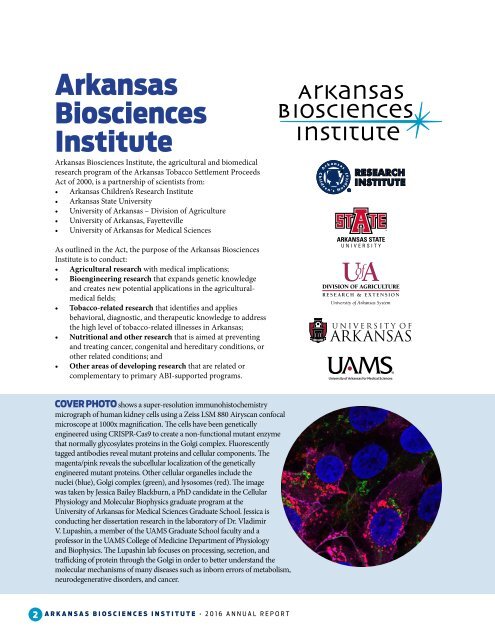ARKANSAS BIOSCIENCES INSTITUTE
Annual-Report-for-ABI-Website
Annual-Report-for-ABI-Website
You also want an ePaper? Increase the reach of your titles
YUMPU automatically turns print PDFs into web optimized ePapers that Google loves.
Arkansas<br />
Biosciences<br />
Institute<br />
Arkansas Biosciences Institute, the agricultural and biomedical<br />
research program of the Arkansas Tobacco Settlement Proceeds<br />
Act of 2000, is a partnership of scientists from:<br />
• Arkansas Children’s Research Institute<br />
• Arkansas State University<br />
• University of Arkansas – Division of Agriculture<br />
• University of Arkansas, Fayetteville<br />
• University of Arkansas for Medical Sciences<br />
As outlined in the Act, the purpose of the Arkansas Biosciences<br />
Institute is to conduct:<br />
• Agricultural research with medical implications;<br />
• Bioengineering research that expands genetic knowledge<br />
and creates new potential applications in the agriculturalmedical<br />
fields;<br />
• Tobacco-related research that identifies and applies<br />
behavioral, diagnostic, and therapeutic knowledge to address<br />
the high level of tobacco-related illnesses in Arkansas;<br />
• Nutritional and other research that is aimed at preventing<br />
and treating cancer, congenital and hereditary conditions, or<br />
other related conditions; and<br />
• Other areas of developing research that are related or<br />
complementary to primary ABI-supported programs.<br />
COVER PHOTO shows a super-resolution immunohistochemistry<br />
micrograph of human kidney cells using a Zeiss LSM 880 Airyscan confocal<br />
microscope at 1000x magnification. The cells have been genetically<br />
engineered using CRISPR-Cas9 to create a non-functional mutant enzyme<br />
that normally glycosylates proteins in the Golgi complex. Fluorescently<br />
tagged antibodies reveal mutant proteins and cellular components. The<br />
magenta/pink reveals the subcellular localization of the genetically<br />
engineered mutant proteins. Other cellular organelles include the<br />
nuclei (blue), Golgi complex (green), and lysosomes (red). The image<br />
was taken by Jessica Bailey Blackburn, a PhD candidate in the Cellular<br />
Physiology and Molecular Biophysics graduate program at the<br />
University of Arkansas for Medical Sciences Graduate School. Jessica is<br />
conducting her dissertation research in the laboratory of Dr. Vladimir<br />
V. Lupashin, a member of the UAMS Graduate School faculty and a<br />
professor in the UAMS College of Medicine Department of Physiology<br />
and Biophysics. The Lupashin lab focuses on processing, secretion, and<br />
trafficking of protein through the Golgi in order to better understand the<br />
molecular mechanisms of many diseases such as inborn errors of metabolism,<br />
neurodegenerative disorders, and cancer.<br />
2<br />
<strong>ARKANSAS</strong> <strong>BIOSCIENCES</strong> <strong>INSTITUTE</strong> • 2016 ANNUAL REPORT


